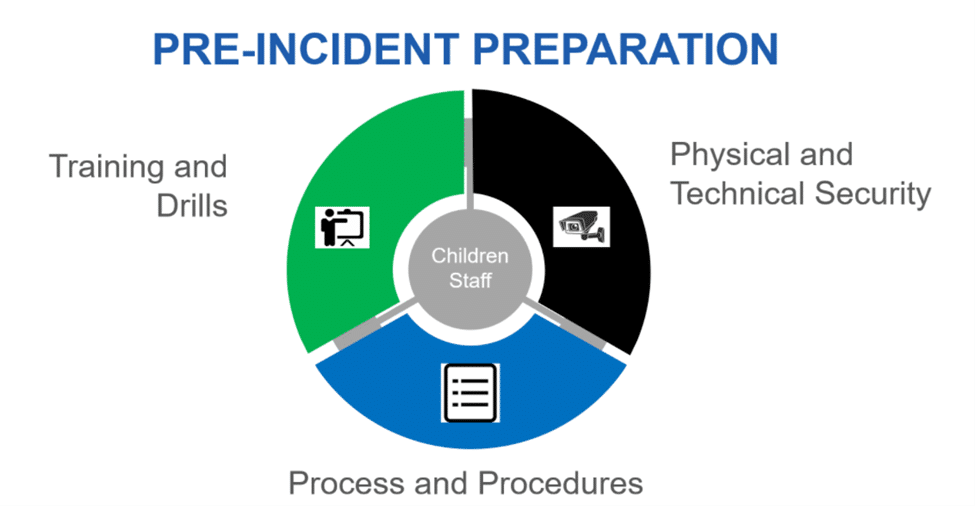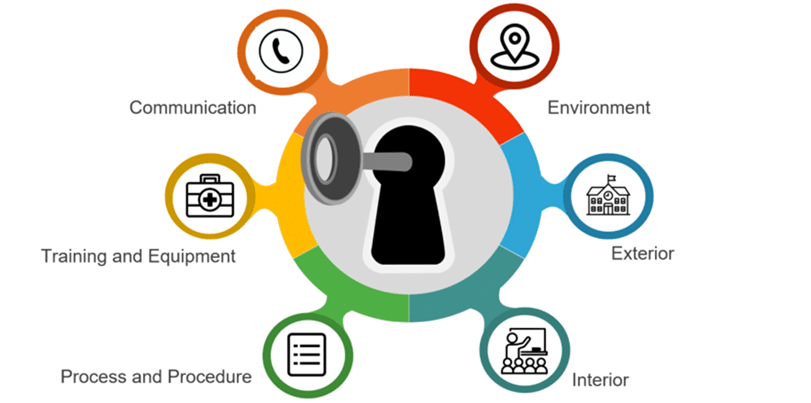
As the old adage goes, “Failure to plan is planning to fail,” and that rings true, particularly when it comes to emergency and crisis situations. In a recent webinar from Early Childhood Investigations, Jason Russell, President of Secure Education Consultants and former member of the U.S. Secret Service, provided strategies child care providers can use to keep their facilities safe and secure.
“I come at this from a unique perspective because not only do I have years of experience serving as a Secret Service agent, but also, people in my family run child care centers,” Jason said.
To adequately address security and safety in early childhood facilities, it’s important to be familiar with the three phases of crisis response:
- Pre-incident preparation: Make sure everyone is trained on your processes. While you may have a crisis or emergency response manual, that manual isn’t helpful if staff members aren’t trained to know what’s in it and how to implement the recommended procedures.
- Incident response: This is how you respond in the moment of the crisis or emergency.
- Post-incident response and communication: Just because an incident is over doesn’t mean you’re done. It’s important to have a plan in place for how you’ll communicate to your staff, families and community what happened and how you addressed the issue – and how you’ll improve for next time, if applicable.
Procare is here to help.
We know the business of child care. For more than 30 years we’ve been guiding child care professionals just like you to help stay connected and in control.
Pre-Incident Preparation
When it comes to pre-incident preparation, there are three areas you should focus on:

- Physical and technical security
Physical security like door locks, cameras, fences, etc. are an important part of a security strategy, but they need to be used effectively.
“Time and time again, I see centers with a door lock system that becomes a glorified doorbell,” said Jason. “It’s important centers have a process that goes along with the door lock, like a set of questions to ask the person to determine if they can enter the building.”
If you have cameras, make sure you have a documented process in place that details who’s monitoring and when, when cameras will be checked to ensure they’re working, how often you’ll review the video, how long you’ll keep the video, etc.
- Processes and procedures: Work to document every potential safety or security issue that could occur at your center and make sure to create a process for how to address it. For example, if you don’t recognize a person asking to gain access to your center and do not wish to permit them to enter based on any questions they may have answered, what do you do next? There should be no question regarding next steps in this situation.
- Training and drills: This is the least-performed step because it requires coordination and a time investment. But it’s critical to ensuring your center is ready to address any security issues. Make it a priority to set aside time to do regular drills and reviews of your policies.
Strengthening Your Security Position
Let’s take a deeper dive into the elements you should be assessing to strengthen your security position.

Environment
It’s important to assess and understand your immediate environment. What is around you? What’s in your neighborhood? Do you have any nearby businesses that could cause issues (i.e. a factory that produces chemicals)? These are important things to consider so you’re fully prepared if an issue arises.
Exterior
This includes playground gates, fencing, exits, space between the street and the entrance to the center, and more.
When you’re assessing exterior security measures, make sure to keep in mind how feasible they are during an emergency. For example, if your school’s fire response is to evacuate everyone to the playground, ensure the playground has an exit away from the school. That way, in the case of a real fire, staff and children won’t be forced to go toward the fire to leave the playground.
Other threats include vehicle strikes. According to Jason, there are hundreds of situations each year where a car drives into a building. Know what your vulnerabilities might be to that end so you can safeguard against it.
Think about where your exterior cameras are positioned. It’s a good idea to have one facing out the front door to better anticipate any potential threats, as well as facing the playground to help document any falls or accidents.
Interior
It’s important to have some sort of entry control system. The best systems allow for dual-factor authentication, which focuses on two things: Who the person is and what they know. For example, a fingerprint can provide the “who the person is” element, while a pin number covers the “what they know” element.
While dual factor authentication is important, it’s also important you have a process in place for granting entry. While 90 percent of those seeking to enter your building are people you already know, it’s critical to plan for that 10 percent of people you don’t know. Jason recommended installing audio capabilities outside the door (like an intercom system) to ensure front desk staff can ask the questions outlined in your process and only let in people who are authorized to be there.
Assess Process & Procedure
Take a hard look at the processes you have in place and make sure they’re updated to reflect today’s threats and challenges. Do you have your bases covered? Look at your emergency plan and make sure you have processes for each of your security protocols, such as a process for reviewing camera footage or for granting entry into your facility.
Look at Training & Equipment
Every staff member should have a basic level of training on security processes and procedures. But it doesn’t have to be an all-day intensive training. You can break it up into bite-sized pieces – for example, review one policy or procedure during each staff meeting.
When it comes to equipment, ask yourself the resources you need to have on hand to support your center’s safety during an emergency. Try to anticipate the unexpected. When Jason’s company recommended – prior to the onset of coronavirus – that centers keep face masks in their emergency kits, they initially questioned the idea. But when the virus hit, centers were prepared, and were even able to help other organizations when masks were in short supply.
A few additional ideas for what you can include in your emergency kit include: bottled water, flashlights, a first aid kit, batteries, hand sanitizer, gloves, non-perishable food and more. You can get a more in-depth list on the CDC’s website.
Communication
Communication is critical during an emergency. There are two types of communication: internal and external. Make sure your staff is well-informed on all your policies and procedures, and make sure they’re kept abreast of any changes you make. If you don’t handle internal communications correctly, that will affect your ability to communicate effectively externally. One way to help ensure you can communicate quickly during or directly following a crisis is to develop pre-written letters, emails, social posts, etc. that you can customize based on the event.
Simplify Response Protocols
Make sure you clearly define the different terms meant to signify an emergency or crisis, and how to respond:
- Lockout – This is the most commonly-used response protocol and is classified as a yellow alert. Here are some procedures and things to keep in mind during a lockout:
- Ensure perimeter is secure
- Discontinue activities outside
- Notification/signage to alert outside people you’re in a lockout
- Be prepared to LOCKDOWN
- Lockdown – This is a red alert situation. Procedures and considerations include:
- Secure yourself and students behind locked door when possible
- Cover and concealment
- Barricade/tether
- Other considerations (lights, cell phones, etc.)
- Evacuate – This is a green alert level emergency. This means the facility is no longer safe to occupy. Make sure you consider things like:
- Evacuation routes – These should be posted prominently in your facility. Schedule regular drills to make sure everyone is familiar with the routes.
- Accountability – Who’s is doing what during the evacuation? Make sure someone is responsible for counting the children before and after evacuating.
- Relocation sites and transportation – Be familiar with what is around you if you can’t re-enter your center. You should have a back-up location to go to, as well as the ability to secure transportation if needed.
- Reunification – Develop a process for how you will reunify the children with their parents.
- Shelter in Place – This emergency protocol deals with non-human threats like weather, chemical spills, etc. Considerations include:
- Sealing up rooms
- Supplies you’ll need on-hand (refer to the emergency kit)
- Utilities that may get shut off – electric, gas, water
To learn more about what you can do to ensure you’re prepared for the next emergency or crisis, you can view the webinar here.
Click here for more information about how Procare can help increase the security at your center or school.



